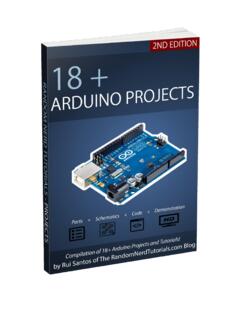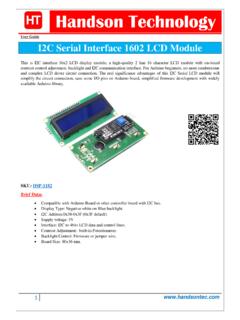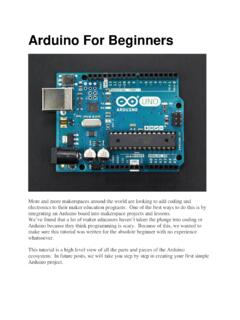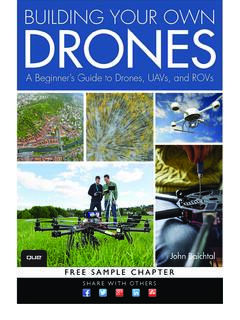Transcription of THE BASIC STARTER KIT TUTORIAL FOR UNO
1 THE BASIC STARTER KIT TUTORIAL FOR UNO 2 / 83 Our Company Preface Established in 2011, Elegoo Inc. is a thriving technology company dedicated to open- source hardware research & development, production and marketing. Located in Shenzhen, the Silicon Valley of China, we have grown to over 150+ employees with a 10,763+ square ft. factory. Our product lines rang from DuPont wires, UNO R3 boards to complete STARTER kits designed for customers of any level to learn arduino knowledge. In addition, we also sell products of Raspberry Pi accessories like TFT touch and STM32. In the future we would devote more energy and investment to 3D printer products and so on. All of our products comply with international quality standards and are greatly appreciated in a variety of different markets throughout the world.
2 Official website: US Amazon storefront: CA Amazon storefront: UK Amazon storefront: DE Amazon storefront: FR Amazon storefront: ES Amazon storefront: IT Amazon storefront: Our TUTORIAL This TUTORIAL is designed for beginners . You will learn all the BASIC information about how to use arduino controller board, sensors and components. If you want to study arduino in more depth, we recommend that you read the arduino Cookbook written by Michael Margolis. Some codes in this TUTORIAL is edited by Simon Monk. Simon Monk is author of a number of books relating to Open Source Hardware. They are available in Amazon: Programming arduino , 30 arduino Projects for the Evil Genius and Programming the Raspberry Pi. Customer Service As a continuous and fast growing technology company we keep striving our best to 3 / 83 offer you excellent products and quality service as to meet your expectation and you can reach out to us by simply drop a line at or We look forward to hearing from you and any of your critical comment or suggestion would be much valuable to us.
3 And any of problems and questions you have with our products will be promptly replied by our experienced engineers within 12 hours (24hrs during holiday) 4 / 83 5 / 83 Content Lesson 0 Installing IDE .. 6 Lesson 1 Add Libraries and Open Serial Monitor .. 17 Lesson 2 Blink .. 26 Lesson 3 LED .. 37 Lesson 4 RGB LED .. 44 Lesson 5 Digital Inputs .. 53 Lesson 6 Active buzzer .. 58 Lesson 7 Tilt Ball Switch .. 62 Lesson 8 Eight LED with 74HC595 .. 66 Lesson 9 The Serial Monitor .. 73 Lesson 10 Photocell .. 79 6 / 83 Lesson 0 Installing IDE Introduction The arduino Integrated Development Environment (IDE) is the software side of the arduino platform. In this lesson, you will learn how to setup your computer to use arduino and how to set about the lessons that follow.
4 The arduino software that you will use to program your arduino is available for Windows, Mac and Linux. The installation process is different for all three platforms and unfortunately there is a certain amount of manual work to install the software. STEP 1: Go to and find below page. The version available at this website is usually the latest version, and the actual version may be newer than the version in the picture. 7 / 83 STEP2 Download the development software that is compatible with the operating system of your computer. Take Windows as an example here. Click Windows Installer. Click JUST DOWNLOAD. 8 / 83 Also version is available in the material we provided, and the versions of our materials are the latest versions when this course was made. Installing arduino (Windows) Install arduino with the exe.
5 Installation package. Click I Agree to see the following interface Click Next You can press to choose an installation path or directly type in the directory you want. 9 / 83 10 / 83 Click Install to initiate installation Finally, the following interface appears, click Install to finish the installation. Next, the following icon appears on the desktop 11 / 83 Double-click to enter the desired development environment You may directly choose the installation package for installation and skip the contents below and jump to the next section. But if you want to learn some methods other than the installation package, please continue to read the section. Unzip the zip file downloaded, Double-click to open the program and enter the desired development environment 12 / 83 13 / 83 However, this installation method needs separate installation of driver.
6 The arduino folder contains both the arduino program itself and the drivers that allow the arduino to be connected to your computer by a USB cable. Before we launch the arduino software, you are going to install the USB drivers. Plug one end of your USB cable into the arduino and the other into a USB socket on your computer. The power light on the LED will light up and you may get a 'Found New Hardware' message from Windows. Ignore this message and cancel any attempts that Windows makes to try and install drivers automatically for you. The most reliable method of installing the USB drivers is to use the Device Manager. This is accessed in different ways depending on your version of Windows. In Windows 7, you first have to open the Control Panel, then select the option to view Icons, and you should find the Device Manager in the list.
7 Under Other Devices , you should see an icon for unknown device with a little yellow warning triangle next to it. This is your arduino . 14 / 83 Right-click on the device and select the top menu option (Update Driver ). You will then be prompted to either Search Automatically for updated driver software or Browse my computer for driver software . Select the option to browse and navigate to the X\ \drivers. 15 / 83 Click 'Next' and you may get a security warning, if so, allow the software to be installed. Once the software has been installed, you will get a confirmation message. Windows users may skip the installation directions for Mac and Linux systems and jump to Lesson 1. Mac and Linux users may continue to read this section. Installing arduino (Mac OS X) Download and Unzip the zip file, double click the to enter arduino IDE; the system will ask you to install Java runtime library if you don t have it in your computer.
8 Once the installation is complete you can run the arduino IDE. 16 / 83 Installing arduino (Linux) You will have to use the make install command. If you are using the Ubuntu system, it is recommended to install arduino IDE from the software center of Ubuntu. TIPS: If you have problems in installing the drivers, please refer to the UNO R3, MEGA, NANO DRIVER FAQ. 17 / 83 Lesson 1 Add Libraries and Open Serial Monitor Installing Additional arduino Libraries Once you are comfortable with the arduino software and using the built-in functions, you may want to extend the ability of your arduino with additional libraries. What are Libraries? Libraries are a collection of code that makes it easy for you to connect to a sensor, display, module, etc. For example, the built-in LiquidCrystal library makes it easy to talk to character LCD displays.
9 There are hundreds of additional libraries available on the Internet for download. The built-in libraries and some of these additional libraries are listed in the reference. To use the additional libraries, you will need to install them. How to Install a Library Using the Library Manager To install a new library into your arduino IDE you can use the Library Manager (available from IDE version ). Open the IDE and click to the "Sketch" menu and then Include Library > Manage Libraries. 18 / 83 Then the library manager will open and you will find a list of libraries that are already installed or ready for installation. In this example we will install the Bridge library. Scroll the list to find it, then select the version of the library you want to install. Sometimes only one version of the library is available. If the version selection menu does not appear, don't worry: it is normal.
10 There are times you have to be patient with it, just as shown in the figure. Please refresh it and wait. 19 / 83 Finally click on install and wait for the IDE to install the new library. Downloading may take time depending on your connection speed. Once it has finished, an Installed tag should appear next to the Bridge library. You can close the library manager. You can now find the new library available in the Include Library menu. If you want to add your own library open a new issue on Github. Importing a .zip Library Libraries are often distributed as a ZIP file or folder. The name of the folder is the name of the library. Inside the folder will be a .cpp file, a .h file and often a file, examples folder, and other files required by the library. Starting with version , you can install 3rd party libraries in the IDE.






